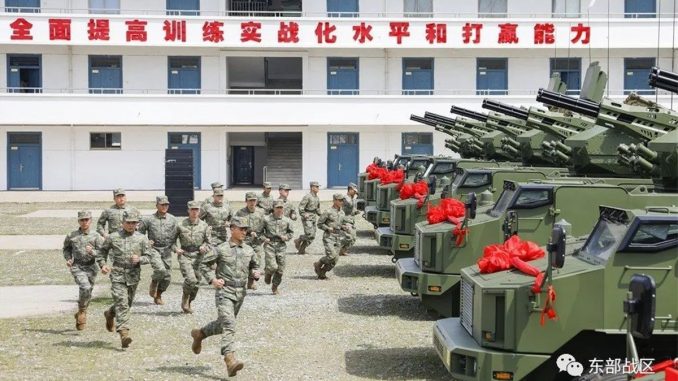
The Chinese People’s Liberation Army (PLA) 71st Group Army, new self-propelled anti-aircraft systems. Photo: Screenshot of WeChat account of PLA Eastern Theater Command
| Published August 20, 2025
China’s People’s Liberation Army (PLA) is rapidly modernizing, aiming to achieve military parity with the United States. As global tensions rise in the Indo-Pacific, Beijing is focusing on three critical areas of military development: information, air, and maritime capabilities. Among these, information dominance forms the backbone of China’s strategic vision, reflecting the PLA’s understanding that modern warfare extends beyond traditional battlefields.
Information Superiority: The Backbone of Modern Warfare
Information superiority has become the cornerstone of modern military strategy, and China’s People’s Liberation Army (PLA) recognizes that controlling the flow of data and intelligence can decisively shape outcomes in conflict. The PLA’s Strategic Support Force (PLASSF) has been at the forefront of this transformation, orchestrating a sophisticated network of intelligence, surveillance, and reconnaissance (ISR) capabilities.
Central to this strategy is the deployment of military imaging satellites capable of monitoring vast areas in near real-time, giving Chinese commanders the ability to track troop movements, missile deployments, and naval operations with unprecedented precision. Over-the-horizon radar systems complement these satellites by detecting aircraft and missile activity far beyond the line of sight, allowing China to maintain situational awareness even in contested regions.
The emphasis on information superiority extends beyond traditional reconnaissance. China is investing heavily in electronic warfare, cyber operations, and space-based assets to disrupt or disable enemy communications and radar systems while protecting its own networks. This dual capability—offensive and defensive—enables the PLA to not only gather intelligence but also deny the same advantage to adversaries, creating a significant operational edge.
Furthermore, information dominance integrates with China’s broader military modernization. By combining real-time intelligence with advanced command and control systems, the PLA can make faster, more informed decisions on the battlefield, coordinating air, naval, and ground operations in a seamless, networked approach. In essence, controlling the information environment has become as important as controlling physical territory.
In an era where cyber attacks, electronic jamming, and satellite surveillance can determine the outcome of conflicts before traditional forces even engage, China’s pursuit of information superiority underscores a strategic understanding: wars of the future will be won first in the digital and electromagnetic domains, not just on land, sea, or in the air.
Air Power: Dominating the Skies
Air superiority remains a critical pillar of China’s military modernization, reflecting the PLA’s recognition that control of the skies is essential for both defensive and offensive operations. The People’s Liberation Army Air Force (PLAAF) has undergone rapid expansion and technological upgrades, emphasizing stealth, long-range strike capabilities, and advanced surveillance systems.
China has invested heavily in next-generation fighter jets, such as the J-20 stealth fighter and upgraded variants of the J-16, designed to compete with the most advanced U.S. aircraft. These jets are equipped with sophisticated avionics, radar systems, and precision-guided munitions, enabling the PLAAF to operate effectively in contested environments. In addition, China is expanding its fleet of unmanned aerial vehicles (UAVs) and drones, providing enhanced reconnaissance, strike capabilities, and persistent surveillance over key areas of interest.
Beyond individual aircraft, China is modernizing its air defense networks and command-and-control systems. Advanced integrated radar, missile defense systems, and electronic warfare capabilities allow the PLA to detect, track, and neutralize threats before they reach Chinese airspace. This integration enhances situational awareness, enabling rapid coordination between air, naval, and ground forces.
Strategically, air power serves as both a deterrent and a force multiplier. By achieving air superiority, China can protect its maritime routes, secure territorial claims, and project military influence throughout the Indo-Pacific. It also ensures that the PLA can respond swiftly to crises, supporting ground operations, amphibious assaults, or missile strikes with precision and speed.
In the modern battlefield, where information and mobility are intertwined, dominating the skies gives China a decisive edge. It allows the PLA to operate with confidence, limit the freedom of movement of potential adversaries, and reinforce its broader ambition of becoming a global military power capable of challenging the United States in regional and strategic theaters.
Maritime Strength: Controlling the Indo-Pacific
China’s maritime expansion is central to its strategy for regional dominance and global influence. The People’s Liberation Army Navy (PLAN) has grown rapidly over the past two decades, evolving from a primarily coastal defense force into a modern, blue-water navy capable of operating far from Chinese shores. This transformation underscores Beijing’s strategic goal: to control key maritime routes, protect trade corridors, and challenge U.S. naval supremacy in the Indo-Pacific.
A cornerstone of this modernization is China’s investment in advanced surface combatants, including guided-missile destroyers and frigates equipped with state-of-the-art radar, missile systems, and anti-submarine warfare capabilities. Aircraft carriers, such as the Liaoning and Shandong, along with newer domestically-built carriers, allow the PLAN to project power across the region, providing air support for naval operations and enhancing China’s reach in disputed waters like the South China Sea and the East China Sea.
Submarines, both nuclear and diesel-electric, form another key pillar of China’s maritime strategy. These vessels enable strategic deterrence, covert reconnaissance, and the ability to disrupt adversary naval movements. Coupled with anti-ship ballistic missiles and long-range precision strike systems, China’s navy is positioning itself as a formidable force capable of challenging any regional competitor.
The PLAN’s modernization is closely integrated with China’s broader military goals. Joint exercises with the PLA Air Force and Strategic Support Force ensure that maritime, air, and information capabilities operate in coordination, enabling rapid responses to regional crises. Protecting vital sea lanes—through which a large portion of China’s trade and energy imports flow—remains a top priority, as these routes are essential to sustaining economic growth and strategic autonomy.
By building a robust maritime presence, China seeks not only to defend its territorial claims but also to assert influence over the broader Indo-Pacific region. This growing capability challenges U.S. naval dominance and forces regional actors, including allies of the United States, to reconsider security strategies. In essence, maritime strength provides China with both a shield and a sword: the ability to safeguard its interests while projecting power across one of the world’s most critical strategic theaters.
 Implications
Implications
-
Regional Security Tensions –
As the PLA strengthens in information, air, and maritime domains, neighboring countries, particularly in the Indo-Pacific, may feel increased pressure. Nations like Japan, South Korea, Taiwan, and the Philippines could face higher risks of coercion or military intimidation. -
U.S. Strategic Posture –
Achieving near-parity could force the U.S. to rethink its military strategy in the region, potentially increasing defense spending, maintaining a forward-deployed presence, and strengthening alliances such as the Quad and AUKUS. -
Information and Cyber Vulnerabilities –
Since information superiority is central to China’s strategy, this implies potential escalation in cyber warfare, electronic warfare, and space-based conflicts. Critical infrastructure and communication networks could become high-value targets. -
Arms Race Acceleration –
As China narrows the technological gap, it may trigger an accelerated arms race, especially in hypersonic weapons, ISR systems, and naval capabilities, compelling both China and the U.S. (and their allies) to rapidly innovate and expand military investments. -
Global Strategic Balance –
Military parity could shift the global power balance, affecting diplomatic negotiations, trade disputes, and international alliances. Countries may align more closely with either China or the U.S., influencing global security and economic policies.
 Overall Takeaway:
Overall Takeaway:
China’s pursuit of military parity with the United States reflects a strategic effort to secure dominance in information, air, and maritime domains. While significant progress has been made, especially in intelligence, surveillance, and reconnaissance capabilities, challenges remain in fully matching U.S. technological and operational strength. Achieving these objectives would have profound implications: heightening regional tensions, prompting U.S. strategic adjustments, escalating cyber and space conflicts, and potentially reshaping the global balance of power. As the PLA modernizes, the international community faces a pivotal moment in assessing security, alliances, and the future of military competition in the Indo-Pacific and beyond.





Be the first to comment